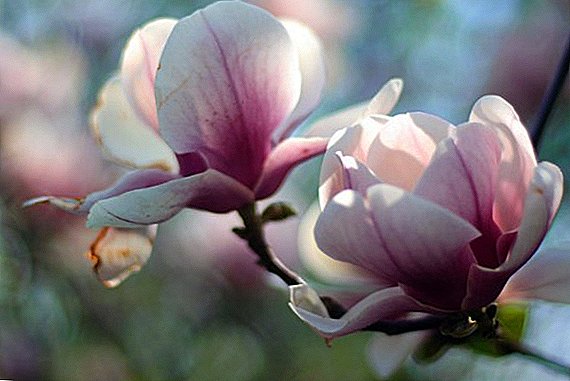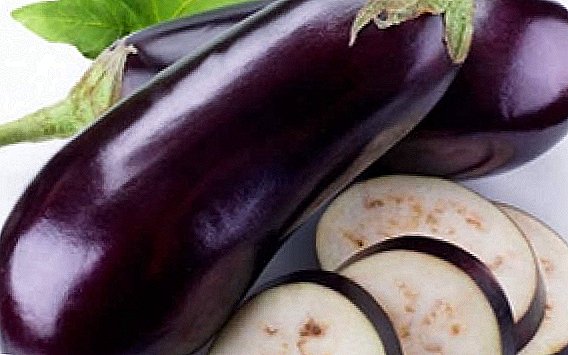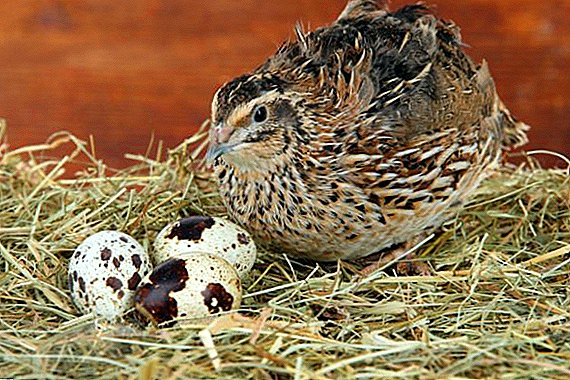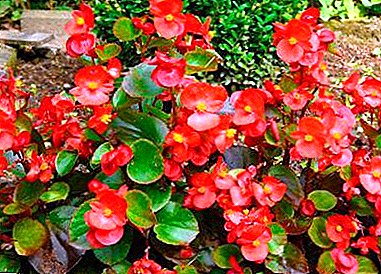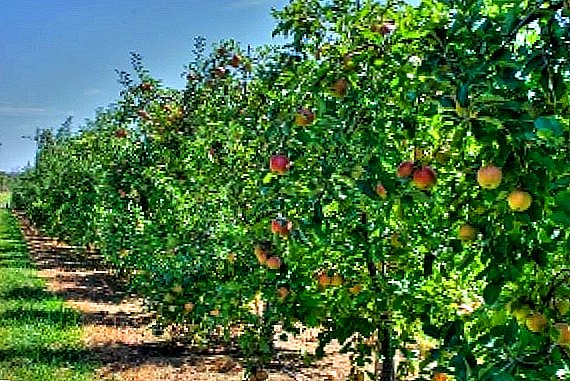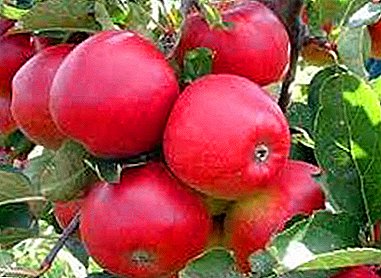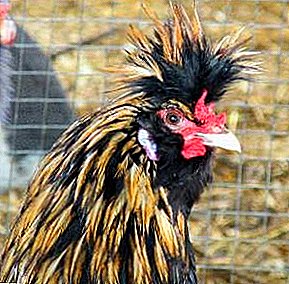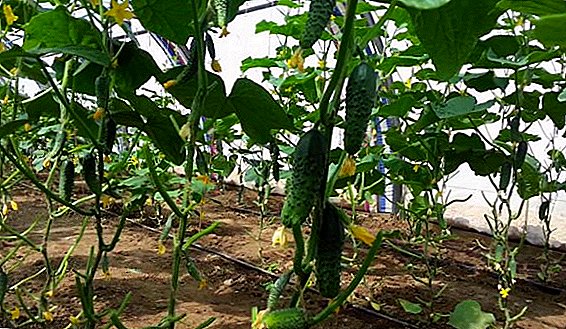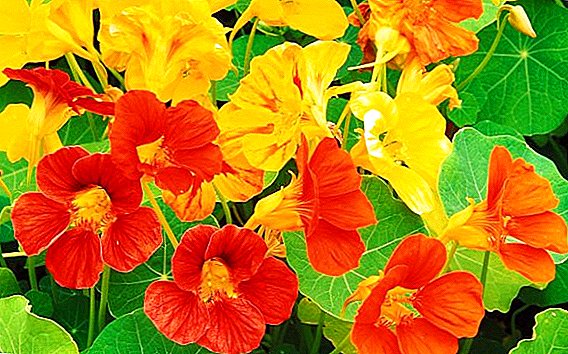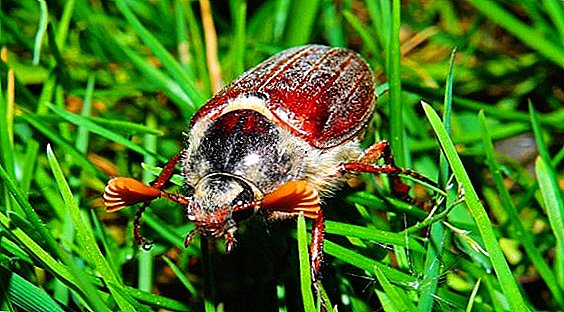 With warming, on the land there are many different insects. Most of them bring obvious benefits: pollinate and cultivate plants. But some of them do more harm than good. Among such malicious insects a special place is occupied by Khrushka. To reduce the damage caused by this beetle, you need to know what preventive measures are effective, and to be guided in the means of dealing with it. About this and talk in this article.
With warming, on the land there are many different insects. Most of them bring obvious benefits: pollinate and cultivate plants. But some of them do more harm than good. Among such malicious insects a special place is occupied by Khrushka. To reduce the damage caused by this beetle, you need to know what preventive measures are effective, and to be guided in the means of dealing with it. About this and talk in this article.
Damage from the May beetle
In the beginning, let's see what this bug is so dangerous for plants. It must be understood that the danger is not only its adult individuals, but also the larvae. And each of them harms in its own way.
What eats may beetle
The harm that the cockchafer does is the peculiarities of the diet of the insect. Its main delicacy is young leaves and shoots of plants. If such a beetle lives on a plot, it can literally in a month or two gnaw a young shrub or tree. 
If we talk about taste preferences, he prefers to eat these plants:
- from decorative: birch, aspen and others;
- from shrubs: lilac, currant and other;
- from fruit trees: apple, sea buckthorn, cherry, plum.
Maybot larva
Larvae of May beetles bring the greatest harm. If adult individuals can be noticed and prevented undesirable consequences of their vital activity, then the larvae are deep in the ground, and their harm, at first, goes unnoticed. At the same time, one voracious larva at the age of three years is able to embrace the roots of a two-year-old pine tree in a day. Two-year cope with this work for the week.
If an adult beetle is rather picky about food, then much more cultures will be included in the diet of the larva:
- tree roots: cedar, spruce, pine, larch, birch;
- berries: strawberries, strawberries and other;
- vegetable crops: various seedlings, corn, potatoes;
- young weeds and lawn grass.

Collection of larvae of the Khrushcha
This is the cheapest method, since it only requires time from the gardener or the gardener. True, this is a very laborious way. It is best to resort to it in the summer, when the larvae, sensing the heat, rise closer to the surface. This time of year it is enough to dig a plot to a depth of 10-20 cm and manually select the larvae. However, we must understand that all the larvae will not be able to get it.
Did you know? Often, the collected larvae are used in fishing. On them, as well as on adults, the asp, ide, chub is perfectly caught.
Soil sowing
 This term refers to the saturation of the soil with nitrogen in a natural way. This is achieved by sowing on the right areas of white clover. Experts have shown that a special bacterium lives on the roots of this plant, which absorbs nitrogen from the air, synthesizing proteins. Saturating the soil with nitrogen, it transfers it to the rhizomes of neighboring plants.
This term refers to the saturation of the soil with nitrogen in a natural way. This is achieved by sowing on the right areas of white clover. Experts have shown that a special bacterium lives on the roots of this plant, which absorbs nitrogen from the air, synthesizing proteins. Saturating the soil with nitrogen, it transfers it to the rhizomes of neighboring plants.
And nitrogen is a very unattractive environment for the life of the larvae of this beetle, as well as a number of weeds. This is the most reliable way to fight insects.
Use traps
Gardeners and gardeners often set traps that help get rid of adult insects. In this case, the question of how to get rid of Khrushcha can be solved in several ways:
- Light trap. The container is coated on the inside with something very sticky (with a special insect glue or grease). A lamp or other light source is installed at the bottom of the tank. The trap is put on the night, including the light. Not only May beetles will fly to it, but also other pests, for example, butterfly-moths.
- Sweet trap. The two-liter plastic bottle is cut so that the walls rise 5-7 cm from the bottom. From above make four holes in which they pass the cord. Inside the container pour kvass or jam diluted with water. These traps are hanging on the trees. Periodically, they should be checked and cleaned from insects.
- Shaking off. During the period when the largest number of adults is observed, they can be collected by shaking off trees or bushes. It is better to do this in the morning, when the air temperature has not yet exceeded the mark of + 15 ° C. At this temperature, insects are inactive, so they can be easily collected after a fall. Collected beetles are often given to poultry as feed.

Important! If earlier, in the fight against insects, you used insecticides, it is not recommended to feed the collected beetles to the bird. They accumulate in the body of harmful substances that can poison it.
Attracting natural enemies
Another safe way to get rid of pests - to attract to the site of those who feed on the May-bug.
These are mainly rooks, starlings and other birds. In this case, help ordinary birdhouses or feeders. But there are other ways to lure the birds to your site. For example, if there is a dead tree on it, plant a fern or other thick plants around its trunk. It will attract birds. Sparrows and tits love to live around bushes and in the midst of dried plants.
 But birds destroy mostly adults. To fight the scourge nesting deep in the ground, it is worth knowing who eats the beetle of the May beetle.
But birds destroy mostly adults. To fight the scourge nesting deep in the ground, it is worth knowing who eats the beetle of the May beetle.
First of all, these are hedgehogs, which willingly dig up and eat the larvae.
Did you know? To attract a hedgehog to the site, it is enough to have a pile of wood, a compost pile or a pile of leaves, branches and plants on the territory of the woodpile. You can buy a special house and attract the animal food. It is important not to give a hedgehog milk, even diluted, as it is bad for his stomach.
Use of plant infusions and decoctions
To protect the garden and garden from insects can be and folk methods. For example, pour the soil onion broth. For its preparation is used onion peel. One part of it is poured with two parts of water and infused for a week. The resulting liquid is diluted with water 1: 1 and watered the soil in the evenings.
Insecticide use
Another question than to poison the larvae of the May beetle, when you need to bring them as quickly as possible. In this case, special chemicals come to the rescue. Most often, used drugs "Bowerin", "Aktofit", "Fitoverm" .
.
They are made on the basis of biological components, therefore, are considered quite harmless to humans and some beneficial insects. For example, they can be used even if an apiary is located nearby.
For adults means "Antikhrusch", but it acts against other insects. Also, it cannot be used if there are already berries on the bushes, and there are fruits in the trees, since its decay period is 45 days.
Preventive actions
In order not to resort to extreme measures, it is worth taking preventive measures in time. Among others, the most effective are:
- Mulching, that is, the shelter of the earth with special materials that regulate the air and water regime in the upper soil layer. These materials include crushed tree bark, chopped straw, wood chips, which prevent the beetles from penetrating the soil and laying eggs there.
- If it is necessary to protect strawberry or strawberry beds, grooves are made in rows 30-40 cm deep, which are impregnated with a 75% solution of karbofos.
- In a bucket of water (10 liters) add half a tablespoon of ammonia. The resulting solution is watered beds.
- Also the larvae are scared away by the cabbage leaves buried in the ground, mustard sprouts. You can plant turnips, elder, turnip, lupine or some cruciferous plants around the beds.
Important! Beetles willingly settle for the winter in manure and compost heaps. Therefore, if a hedgehog has not yet settled in it, closer to winter, it is better to scatter a bunch - the larvae do not tolerate cold. But it is better to put a plastic film under it in advance, which will not allow bugs to dig into the soil for the winter.

As you can see, the cockchafer does a lot of harm, but you can fight it. There are various ways to remove it from the site. Some are more expensive, others are less dangerous, but you can always find the right one. However, to protect your crop, it is better to carry out preventive measures in time.


